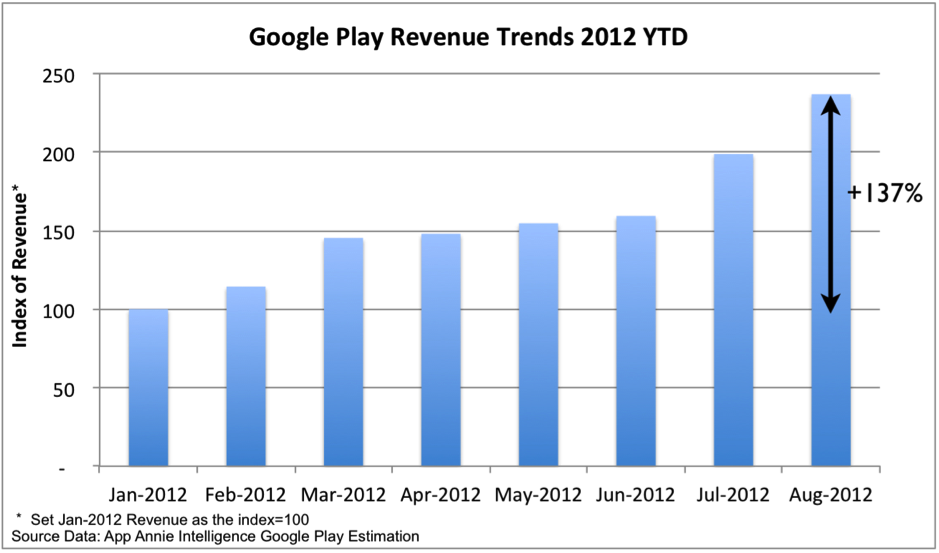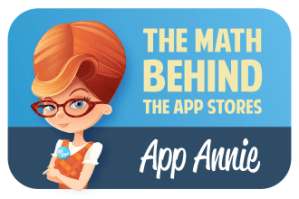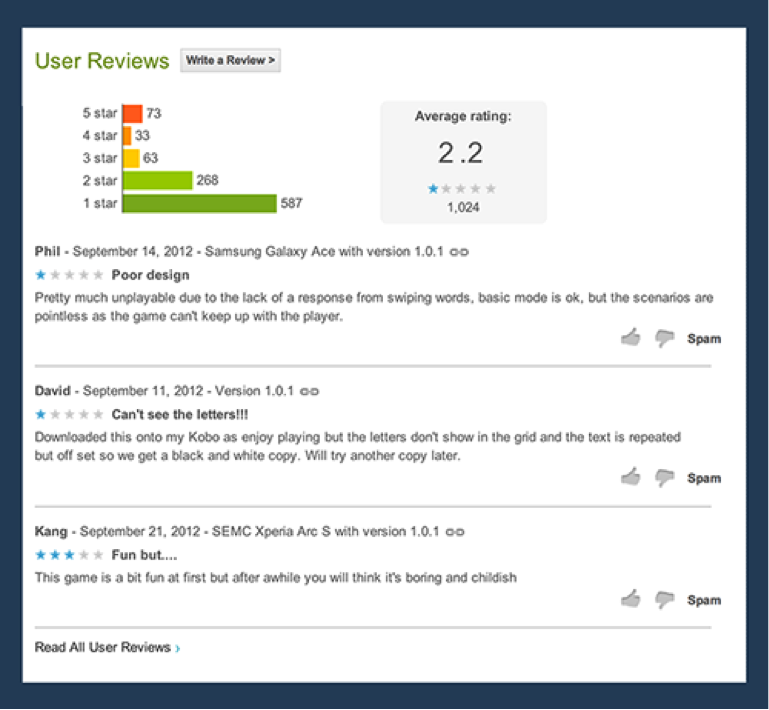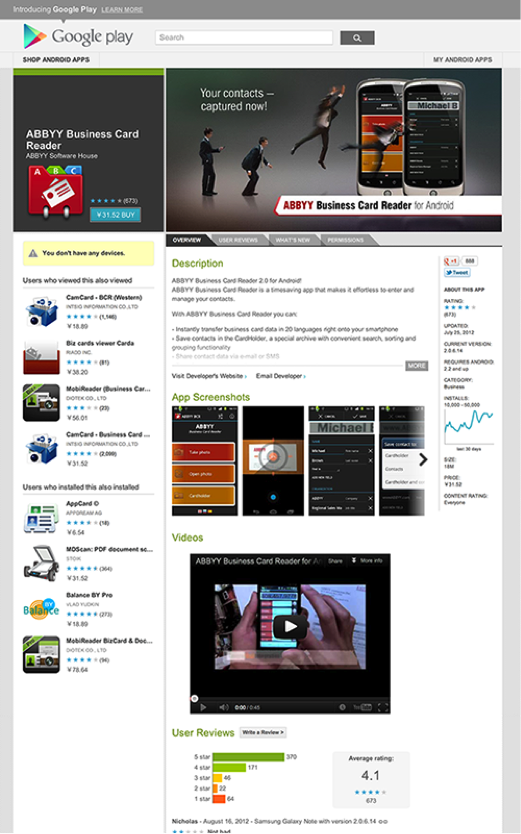Editor’s note: Oliver Lo is vice president of marketing for App Annie. Prior to App Annie he was the product lead for Zynga China and previous to that the marketing lead for XPD, a social gaming start-up that was acquired by Zynga. Follow the company on Twitter.
Developers the world over are looking to cash in on the Google Play gold mine, and with 137 percent revenue growth in the first seven months of this year [1], we really can’t blame you for getting a bit excited. It’s easy to get starry-eyed when you see Rovio’s Angry Birds franchise making $100 million a year, not to mention Instagram’s insane buyout.

The hard truth is that success rates for apps are extremely low, and the probability of failure is very high. In fact, between Feb. 1 and June 30, 2012, there was an average of 828 Google Play apps released every days [2]. That’s three new apps every five minutes, all day, every day.
Those numbers are daunting, especially when you’ve invested hundreds, if not thousands, of hours into development. So, what does it take to stand out in the crowded Google Play marketplace?
How To Avoid Obscurity And Become Loved By All
Successfully publishing an app on Google Play isn’t merely a case of submitting your finished code and sitting back to watch the downloads and dollars flood in. There are many steps that need to be taken in between the final build and the first download — steps that can easily be overlooked in the excitement of getting your hard work into the market.
To help you cover all your bases, we’ve put together a definitive checklist of what to do, as well as when to do it, so that your app lands in the market in the best position possible. We’ve tapped a few successful developers whose apps have been downloaded more than 420,000 times, to give a heads up on what drives success on Google Play and the mistakes they’ve learned not to repeat.
We can’t guarantee that these steps will put you on the Top Charts overnight (after all, there’s only so much demand for flashlight apps), but nailing down the basics can set your app up for success by providing more opportunity to be noticed. Driving app discovery can only take you so far, however, as you’ll need to provide users with an engaging app that fills a niche in order to drive downloads, and ultimately revenue, to avoid slipping into obscurity.
 App Annie’s Checklist For Launching On Google Play
App Annie’s Checklist For Launching On Google Play
When it’s your first time, you are no doubt going to feel excited, nervous, sweaty and hopeful that you’re putting everything in the right place … and launching your first app is no different.
But with so many moving parts to take care of, if you don’t have a structured plan it may not be the smooth, enjoyable experience you’d hoped for.
So you can stop worrying if all your bases are covered. We’ve developed a definitive, interactive checklist designed to be used once your code is done and you’re ready to launch your app. We’ve structured the checklist into six sections, covering critical steps from testing, to publishing, to marketing and more.
1. Testing Your App; It’s Not Sexy, But Neither Are Fatal Exceptions
Thorough testing can mean the difference between glowing reviews or a wave of negativity.
One of the challenges of testing for Google Play is that Android is an open platform that has its pros and cons. There are more devices and more users to reach; however it comes at the cost of extensive device fragmentation, making it challenging to ensure a consistent user experience.
Compared to testing on one device for iOS, thoroughly testing your Android app means checking across a large array of models, canvas sizes and form factors. According to analysis by Open Signal Maps, there are nearly 4,000 types of Android devices. But there are two variables that are the most important to test for: screen size and Android OS version.
Screen size. Jon Rathsman, senior Android developer at Zinply, a digital magazine subscription service, made the decision upfront that they would not try to support any devices with a screen resolution below 800 x 480.
Since we’re a magazine service it doesn’t really make sense to read … on a really really small screen, so we targeted 800×480 which was the standard for high end devices when we started to develop (the app).
Zinply even included this information in the first line of the app description on the Google Play store to make sure that potential users can check if the app will look good on their devices. Zinply was also tested on devices with a higher resolution, such as tablets, to make sure the graphics didn’t lose quality when scaling up.
Android has its own architecture to support scaling up or down, called Density Independent Pixels. However, when the guys at Zinply tested this architecture, they weren’t happy with the results. So they decided to implement their own scaling architecture in order to have full control rather than rely on Google’s, which could lead to unpredictable results.
Make sure that you test for both higher and lower resolutions, and have a plan for how you will cater to both.
Android OS version. When developing an app, you need to choose which OS version will be your base level of compatibility. If you pick Honeycomb (Android 3.x), your app might run on earlier versions, but it might not perform well if you’re using newer features like hardware acceleration (only available since Honeycomb).
Bad performance results in unhappy users, which results in bad reviews. Zinply addresses this by using Eclair (2.1) as its baseline for development, ensuring a wide base of compatibility, and then enabling additional features (like hardware acceleration) only for newer devices. This way you get the best of both worlds.
How to test. The list of devices to test on is called an MDL, or Manufacturer Device List. A large game developer may test an MDL of 100 devices with four types of tests called “Must Test,” “Test Once,” “Installation Test,” and “Test as you want.” Obviously, “Must Test” devices are where most of the quality assurance time is spent.
Unless you have the resources of the likes of Zynga, you’re probably not going to have 100 different phones just lying around. It’s important to test on every device you can get your hands on and make sure to test across a variety of screen sizes, OSes, makes and models. We’ve listed six devices in the checklist as a good starting point.
Remember to define device compatibility in your manifest settings. The Google Developer Console offers a couple of tools under “Device Availability” to review which devices can discover your app in the marketplace and that enable you to manually exclude specific devices that you don’t want to support.
Key differences between iOS and Android. It’s not just device characteristics you need to test for. If you’ve previously published apps on iOS and you’re looking to port to Google Play, make sure you’re prepared for differences like “no server to server verification,” says Rathsman, which can be important if you’re delivering extra content through in-app purchases.
Another key difference is Google Play’s digital rights management (DRM) system. This can cause headaches if your app is designed to work offline, as the developers of ABBYY Business Card Reader, a popular paid app in the “Business” category, discovered. Michael Shoubin, Head of the Internet Sales Group at ABBYY observed [indirect quote]:
DRM is designed to protect applications from piracy, but unfortunately the Google Play Applications Licensing System tries to authenticate the license almost every time the app starts, which requires a data connection. One of the key features of ABBYY mobile apps is that they work offline, without a data connection. We found that some customers were suffering – the app wouldn’t start without a data connection and if you’re travelling to an overseas conference, and you’re trying to scan a business card, it can be really expensive if you need a data connection. To fix this we removed the Google Play Application Licensing System.
ABBYY made this decision about a year ago, so it is possible that Google has already fixed the problem, but you definitely need to test it by yourself.
Remember, not thoroughly testing can mean that your first reviews are bad reviews.
2. Setting Up On Google Play
When setting up your app on Google Play, there are a few key steps and decisions to make. First, if you intend to sell apps or generate revenue from in-app purchases, you must set up a Google Checkout Merchant Account. One of the biggest criticisms of the Google Play market is that Google Checkout does not work in all countries. This can limit the countries in which you can monetize, including big market opportunities such as China.
Second, unlike iOS, which lets you release subsequent versions of an app as an update, if you want to publish a free app on Google Play, you cannot change it to a paid app in the future. Therefore it pays to establish a deliberate, long-term monetization strategy from the get-go.
3. Preparing To Publish On Google Play
Now that your app is ready to publish on Google Play, don’t ruin your chance for success by being sloppy about your presentation to attract potential users.
Make sure you’ve got a beautiful icon, screenshots of the app’s killer features, and a clearly written app description. But the most important thing to take advantage of is that, unlike the Apple App Store, Google Play supports video! Of course, Google’s advantage is that it owns YouTube, so it is only natural to integrate video into Google Play.
For example, the ABBYY Business Card video was a key marketing tool that has received more than 66,000 views on YouTube, and it’s just a simple over-the-shoulder demonstration video without fancy editing. A good demo video can go a long way to make it easier for people to understand your app. Just grab a friend with a decent camera phone and have them record you using the app. There’s no excuse not to do this and it can make a huge difference.
Also consider if you want to do a staged launch by initially limiting the release of your app to a minor market so that you catch any errors you might have missed before releasing in the major markets.
4. Marketing Your App
When launching your app, remember to seek out relevant journalists and review sites before the release. Michael says, “We Google the most popular sites that are focused on reviewing mobile applications, and where our competitors have reviews.”
When contacting reviewers, make sure there’s a way for them to access your app for free. Unlike the Apple App Store, you can’t offer promo discount codes in the Google Play Store. So you need to use a third-party service like Appia or prepare a special build just for journalists.
In order to be independent of third-party mechanisms for discount codes, ABBYY included their own licensing module inside their Android apps, which means they can provide their apps to reviewers for free (don’t make reviewers pay!). This module is included in a special build of the app intended for distribution beyond the Google Play Store (this is impossible on iOS as you can distribute your apps only through the App Store).
When it comes to getting coverage online, remember to think outside of the box. Going beyond the standard app review sites, look at the journalists discussing tools for the market you serve. For instance, if you have an app that helps photographers take landscape photos (like The Photographer’s Ephemeris), reach out to landscape photography blogs and Flickr groups, even if they haven’t reviewed an app before.
Beyond the usual PR practices, there are a number of other ways to build awareness of your app and attract new users. Google’s AdMob provides a method to promote your app within other apps. Facebook fan pages and Twitter streams are must-have social media platforms to communicate with and reach out to current and new users.
Promoting your app on Android app discovery platforms such as Appolicious will also give you a leg up on your competition. Of course, one of the cheapest and easiest ways to seed users is to ask and incentivize your friends and family to download, rate and review your app.
Although it seems there are endless marketing steps to take, it is crucial to be diligent about them or risk sacrificing valuable downloads.
User acquisition is a big topic by itself, and we can’t possibly do it justice in this article, as there are literally hundreds of different tools, products and services available. Keep an eye on the App Annie blog and we’ll look to cover this in more detail in the future.
5. Supporting Your App
If you’re asking users to pay for your app or make in-app purchases, the quickest way to bad reviews is not having good support.
When you’re sitting on a train on the way home from work and you’ve just spent $0.99 on a game that’s not working, you find yourself morphing from a rational, kind individual into a rapid fire-breathing insane user who is out for blood.
As a developer, be prepared and take steps to minimize backlash.
Include information, both in your app and on the Google Play listing, on how to receive customer support. A really simple way to handle this is to set up a specific email address solely for support, and then create an automated response using the out-of-office or vacation-responder. Make sure that your automated response does more than just acknowledge that the support request has been received. It should include answers to common questions, enabling your customers to solve their own problems quickly and without hassle.
A crucial but easily overlooked step is to make sure you test that the email works. If your customer has already turned into a rapid fire-breathing insane user, imagine what an undeliverable email could do to a review.
Some customers, especially those in Asia and Latin America, suffer from problems with their credit cards. Google Checkout has strict payment protection mechanisms that do not accept some types of cards. Be prepared to support customers suffering from those exceptions.
6. Tracking App Performance
Finally your app is in the market! Congrats! Well done! High fives and beers all around.
But now you probably want to know if your app has hit No.1, how much money you’ve made, and if you can go and buy that Giant Japanese Mech-Warrior Robot you’ve been drooling over.
You also want to know how you can improve your app or distribution strategy to enhance your success. Luckily for you, there are a number of existing tools for you to analyze performance and shift your strategy to maximize ROI.
There are two main types of analytics tools: in-app analytics, which monitor what’s happening when users are inside your app, and marketplace analytics, which monitor your app’s downloads, revenues, reviews and rankings.
Some popular in-app analytics tools are Flurry and Google Mobile App Analytics, both of which require you to implement an SDK, so make sure you do this before preparing your final build.
Tracking Store Analytics With App Annie Analytics
Do you know how many sales and downloads your app got today? What about how your app is ranked across categories and countries? Or where it’s been featured?
App Annie Analytics and Store Stats can help you track your app’s performance in the Google Play marketplace. It can also help you dive deeper and break down your data by country and source. Analytics and Store Stats are completely free and enable you to monitor your app without having to log into your developer console every day.
You can also get your app’s stats delivered straight to your inbox daily with a juicy email summarizing your sales and downloads.
Create an account with App Annie before your app has launched, then connect your developer account and let App Annie help you keep track of downloads, revenues, reviews, and more!
Click here to sign up for App Annie Analytics.
Conclusion
With this comprehensive checklist in hand, we’ve given you a head start on a great foundation to ensure the best chance of success on Google Play and put you in a better position to take charge of your app’s distribution and marketing strategy.
Once your app is live on Google Play and your downloads are rolling in, do be sure to let us know if you ever do get that Giant Japanese Mech-Warrior Robot.
For their support in making this guide possible, special thanks to Martin Nilsson, CTO and Jon Rathsman, Senior Android Developer at Zinply, and Michael Shoubin, Head of Internet Sales Group at ABBYY.
Zinply, the latest app from the makers of Paperton, is a cross-platform service that lets you subscribe to magazines without commitment. Check out Zinply on Google Play. ABBYY Business Card Reader is a time-saving app that makes it effortless to enter and manage your contacts. Check out all of ABBY’s apps on GooglePlay here.
Footnotes
1 Total revenue from apps in the Google Play marketplace worldwide from January to August 2012, as calculated by App Annie Intelligence including paid apps and apps with in-app purchases.
2 Total amount of apps released during January to June 2012 on the Google Play marketplace, as monitored by App Annie was 177,750.


